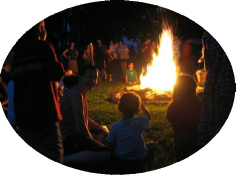|
From Castlebar - County Mayo - Nostalgia The evening of June 23, St John's Eve, is the eve of celebration before the Feast Day of St John the Baptist. The bible states that John was born about six months before Jesus, therefore the feast of John the Baptist was fixed on June 24, six months before Christmas. This feast day is one of the very few saints' days to mark the supposed anniversary of the birth, rather than the death, of the saint commemorated. The Feast of St John coincides with the June solstice also referred to as Midsummer. The Christian holy day is fixed at June 24, but, in some countries, festivities are celebrated the night before, on St John's Eve. The feast is celebrated in various countries. In the west of Ireland this was the traditional night for the Bonfire. This celebratory bonfire was so called as in the past old bones were burned in this fire. In fact in the Irish language of Erris the bonfire is called "Tine Cnáimh" which literally means fire of bones. For several days beforehand, children and young people went from house to house asking for donations for the blessed fire. It was considered very unlucky to refuse. In fact, at some fires, the names of generous donors were called out and the crowd would cheer. But then, the names of the miserly were also announced and these were greeted with jeers and catcalls. In olden days the fire used to be lit exactly at sunset and had to be watched and tended until long after midnight. Prayers use to be said to obtain God's blessing on the crops, then at the peak-point of summer bloom. In many places, the older people continued the preliminary proceedings with more prayers. Afterwards, the merry-making began. As the flames and sparks shot up, loud cheers would arise from the crowd, horns were blown and some people beat on tin cans. The musicians struck up and the young men asked their partners to dance. In-between sets, songs were sung; stories were told, and soloists - musician or dancer - demonstrated their talents. By now the fire would be well ablaze. People leapt through the flames for luck in a new venture, or marriage, when trying for a baby, for good health and for self-purification. Farmers leapt high so their crops would grow tall. In many places, a young woman and man would join hands and jump together. Often, this was nothing more than a mere flirtation, but onlookers took it for granted that there was some intention of marriage between the pair. Some observers would even go as far as to predicting the outcome of such a union by the way the flames flickered as the couple jumped! Some people used to take the ashes from the fire then extinct on St. John's morning to scatter them on their fields. At the close of the festival too about after midnight any man who had built a new house or had nearly completed it took from the bonfire a shovel of red hot sods to his new home so that the very first fire there would be started by the ceremonial bonfire. It was believed that a house built on a path frequented by the fairies would suffer as a result of supernatural manifestations. Perhaps too, ill luck in the farm or personal illness might afflict the family. One remedy for these evils was to bring on St. John's Eve portion of the blessed fire and to build with them on the path in several places small fires which would be left burning until morning. Thomas Flanagan in his book "The Year of the French" refers to the traditional Bonfire in Killala: "Soon it would be Saint John's Eve. Wood for the bonfire had already been piled high upon Steeple Hill, and when the night came there would be bonfires on every hill from there to Downpatrick Head. There would be dancing and games in the open air, and young men would try their bravery leaping through the flames. There would even be young girls leaping through, for it was helpful in the search of a husband to leap through a Saint John's Eve fire, the fires of midsummer. The sun was at its highest then, and the fires spoke to it, calling it down upon the crops. It was the turning point of the year, and the air was vibrant with spirits." There are many bonfire customs associated with Midsummer celebrations. Generally the dates celebrated are 23 June- St. John's Eve which is sometimes called Bonfire Night. It is known in gaelic as: Oiche an tine Chnáimh or Tine Féil Eóin. The fire must be lit exactly on sunset and must be watched till the next morning. The fire and its ashes brought blessings on to the crops. Fires were made to be circular in form- a holy shape. Music, dancing and games were popular along with feats of strength. Bonfires were set close to the graveyard and or holy well. Fires were made from turf, furze bushes and other firewood.
All ages took part.
From: Kevin Danaher: The Year in Ireland, Mercier Press, Dublin, 1972For more folklore from around Mayo see Clogher Heritag Website. http://www.clogherheritage.com/folklore.html
© Copyright 2013 by Castlebar - County Mayo - |
